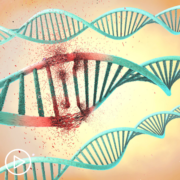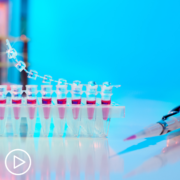Essential Testing for Lung Cancer Patients: How Results Impact Treatment Choices from Patient Empowerment Network on Vimeo.
What testing should take place after a lung cancer diagnosis? Dr. Jessica Bauman discusses the various imaging and molecular tests for lung cancer, and how the results may inform treatment choices.
Dr. Jessica Bauman is assistant professor in the department of hematology/oncology and as associate program director of the hematology/oncology fellowship training program at Fox Chase Cancer Center in Philadelphia. Learn more about Dr. Bauman here.
See More From the The Pro-Active Lung Cancer Patient Toolkit
Related Programs:
Transcript:
Katherine:
Dr. Bauman, what testing should take place following a lung cancer diagnosis?
Dr. Bauman:
So, this very much depends on how the cancer was diagnosed initially. So, some cancers are diagnosed on screening – lung cancer CTs right now – but other cancers are found incidentally, for other reasons. Or there are some that are diagnosed with a scan because somebody’s developing a symptom. So, in general, what I would say is that we always need good imaging essentially of the entire body when a lung cancer is suspected. Often this includes CAT scans, but this very commonly also includes a PET scan. And it will often include a brain MRI as well because the best way to the look at the brain is with an MRI.
Obviously, that can vary a little bit depending on what studies people have already had and what radiologic techniques are most accessible.
Katherine:
What about molecular testing and biopsies?
Dr. Bauman:
So, sorry, I was sort of going on the imaging. But so, of course, you need full imaging. But the first thing you need to do that is paramount is establishing a histologic diagnosis, which goes to this initial thought of, “Is this small cell? Is this non-small cell? What is it?” So, if there is a lung mass that is suspected to be lung cancer, the first thing that happens is a biopsy as well as imaging. The imaging helps us establish, “Has this gone anywhere else? Does it involve the lymph nodes?” and helps us with the initial staging workup. Often there is a biopsy of the mass itself.
But there are often biopsies as well as the lymph nodes that are involved, in particular in the center of the chest called the mediastinum, because that also helps us establish the stage of the cancer.
And then if the cancer does look to have spread to somewhere else, we sometimes biopsy only that area or that area in addition to establish that it, in fact, has spread to a different place such as the liver or the bone. Once that biopsy is done, and once we know what type of lung cancer it is, then we also send more studies on the biopsy itself that help us determine what the best treatments are, in particular when we’re talking about what I call “systemic treatments.”
So, treatments that are going into the body and all over the body that involved immune therapies, chemotherapies, or targeted therapies. So, that extra testing that we do is something that’s called molecular testing.
It’s also called next generation sequencing. There are a bunch of different terminology that we use.
Katherine:
Okay. Dr. Bauman, would you walk us through how lung cancer is staged? And is it different for small cell vs. non-small cell lung cancer?
Dr. Bauman:
Absolutely. So, as we talked about, the first thing that we do is we do get a biopsy to establish the diagnosis. The second piece is often if it looks to be a cancer that is only limited to the chest – so there is a mass and maybe some activities in lymph nodes that we’re concerned about but nowhere else – not only do we want to biopsy the mass itself, but we also want to know whether those lymph nodes are involved. So, those are biopsied because that will tell us the stage of the cancer. Staging very much depends on the size of the tumor itself, and then it also depends on, “Has it spread to lymph nodes in the center of the chest, and has it spread outside of the chest to other places?”
And so, early-stage lung cancers are just the primary cancer itself that has not spread anywhere else. More advanced stage lung cancers – things like stage IIs and stage III lung cancers – are ones that also involve the lymph nodes. And then a stage IV lung cancer involves a lung cancer that has spread to somewhere outside of the body. And depending on the stage is really what determines the way we approach treatment for these patients.
Katherine:
And that is actually my next question. What do the results of these tests tell us about prognosis and treatment choices?
Dr. Bauman:
So, they tell us stage, and, ultimately, prognosis and treatment choices are completely linked to the stage of a cancer. So, an early-stage lung cancer, often a stage I or stage II lung cancer, primarily our first choice of treatment is surgery. And if surgery is feasible for the patient – because, of course, it also depends on their other medical comorbidities and whether they can withstand a surgical resection of the cancer.
But usually, early-stage lung cancers we start with surgery. And then depending on what the pathology shows us, we sometimes include a course of chemotherapy afterwards to decrease the risk of the cancer coming back. More advanced lung cancers, so stage III lung cancers, often involved what we call “multiple modalities.” So, for some patients we do a combination of chemotherapy and radiation in an attempt to cure the cancer. Often that is followed by immunotherapy. There are other patients who have stage III lung cancer where we do chemotherapy and radiation and follow that with surgery.
So, it’s a very case-dependent decision algorithm, where it really depends on where the tumor is, the type of tumor, what the surgery would be, what the patient’s underlying health status is, etc.
And then if it is a stage IV cancer, often we are really approaching this with systemic therapies. So, once a cancer has spread outside the lung, we traditionally think of this often as an incurable cancer. And there is a much more limited role of surgery and radiation, though I wouldn’t say that they’re absolutely off the table. Again, we sometimes think of these in sort of a case-by-case scenario. But in general, our approach for a stage IV cancer is with some kind of systemic therapy. And that completely depends on all those special tests that we do that we were talking about that we send on that initial biopsy.
Katherine:
What about the significance of chromosomal abnormalities?
Dr. Bauman:
So, what I would say is, what we do for, in particular, in the setting of a stage IV lung cancer diagnosis right now, is we send molecular testing on the biopsy samples of these patients, in particular if they have adenocarcinoma.
And the reason we do this, what this gives us, is it tells us about the DNA of the tumor, and whether there are genes in the tumor that are changed in some way that are affecting the cancer’s ability to grow. And the reason that’s so important, is there are new treatments that really capitalize on those changes in the tumor to be able to stop the cancer from growing. The best example of this is for people who have something called an EGFR mutation.
And there are multiple different kinds of mutations. I call it “alphabet soup” because there are so many different letters and numbers.
But if people have an EGFR mutation that we think is one of the primary reasons they have this cancer growing, there are pills that target that EGFR protein that stop the cancer from growing. But if they don’t have that mutation, then those pills are not going to do them any good.
And so, that is really where lung cancer treatment and diagnosis has become so personalized based on, of course the person itself, but also the characteristics of their tumor.





























